Kith and kiln
March 2, 2020
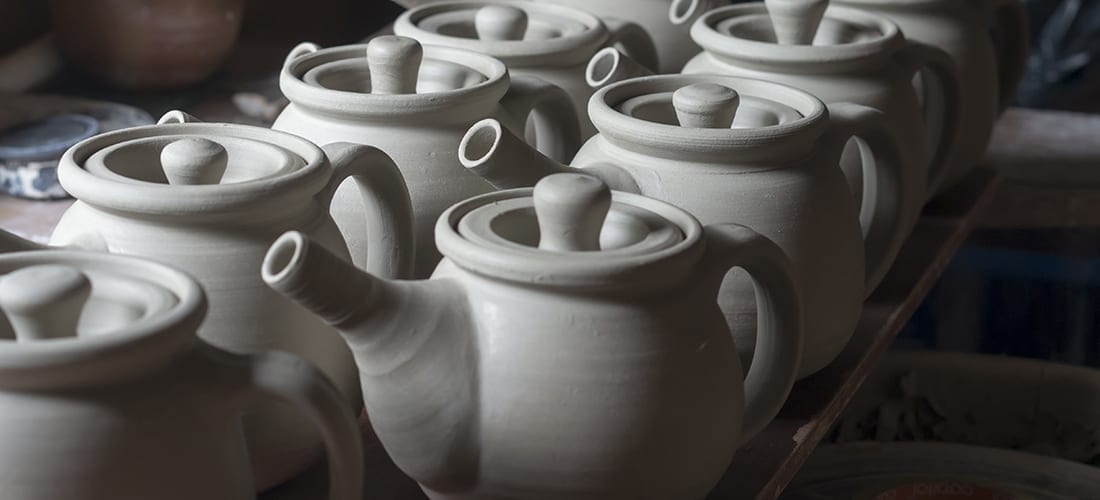
Twice a year, Seagrove potters open their studios for tea and demonstrations.
by Vanessa Infanzon
Pick out a piece of pottery at The Mint Museum’s store in uptown or on Randolph Road, and there’s a chance the artist is from Seagrove, a small town just 90 minutes northeast of Charlotte in Randolph County. Despite its tiny population — 218 residents, according to the latest census — the area is home to more than 100 potters and bills itself as “The Handmade Pottery Capital of the United States.” Seagrove gained national recognition as a pottery town in the early 20th century, though its roots run much deeper, back to the 1700s when European immigrants settled in the area and made and sold pottery to supplement farming income.
Twice a year, a group of Seagrove potters roll out the welcome mat and invite visitors to enjoy tea and baked goods while visiting the studios. The next Tea with Seagrove Potters will be held March 14. It’s a self-guided tour and a chance for a personal introduction to this pottery mecca, or a reintroduction to the talents of these local artists. Visit various studios and galleries — most are within a 5-mile radius — and learn about the artists’ processes and design styles. Here are six Seagrove potters you can meet on the tour.
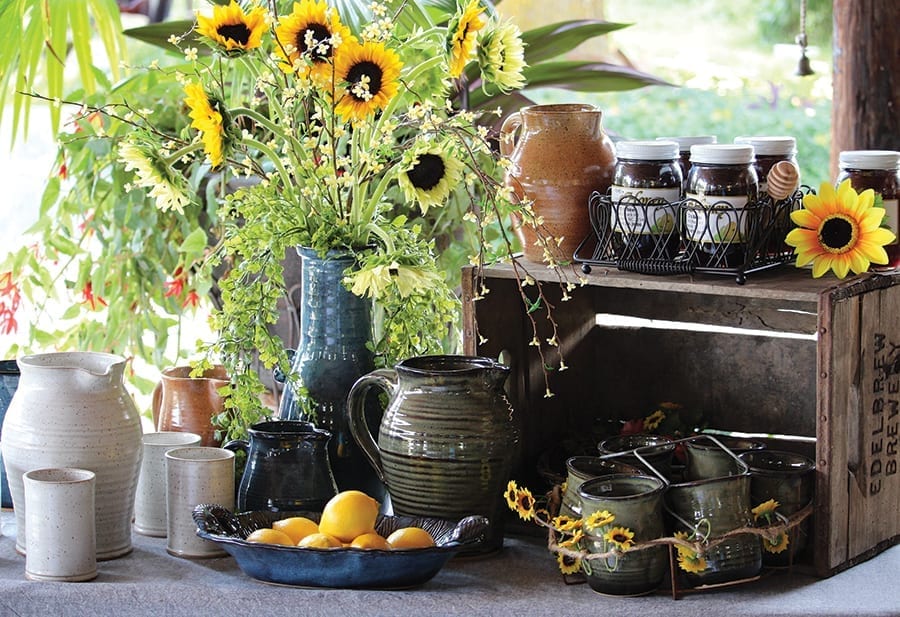
Blue Hen Pottery
Anne Pärtna started making pottery while in high school in her home country of Estonia. An exchange-student program introduced her to ceramics at East Carolina University in Greenville. After graduating from the Estonian Academy of Arts, she returned to ECU for graduate school to study ceramics. She and her husband, Adam Landman, met at ECU and opened Blue Hen Pottery in 2011.
That same year, Blue Hen’s wood kiln was built as part of an international workshop with undergraduate and graduate students from ECU and Estonian Academy of Arts.
Influenced by her beekeeper grandfather, Pärtna draws whimsical bees and flowers — even farm animals such as chickens —on the mugs, bowls, plates, vases and other salt-glazed wares. “A lot of our work takes a long time to make,” Pärtna says. “We put a lot of attention to details.”
Making a teapot is particularly detail-oriented work, requiring attention to design that many other pottery pieces don’t need. There are several parts to put together, and it needs to fit comfortably in your hands and pour well.
Blue Hen is a natural fit for Tea with Seagrove Potters: “Estonians drink a lot of tea,” Pärtna says. “We still have this practice of gathering our own herbs and drying them for the winter, and then we make herbal tea.”
247 West Main St., Seagrove
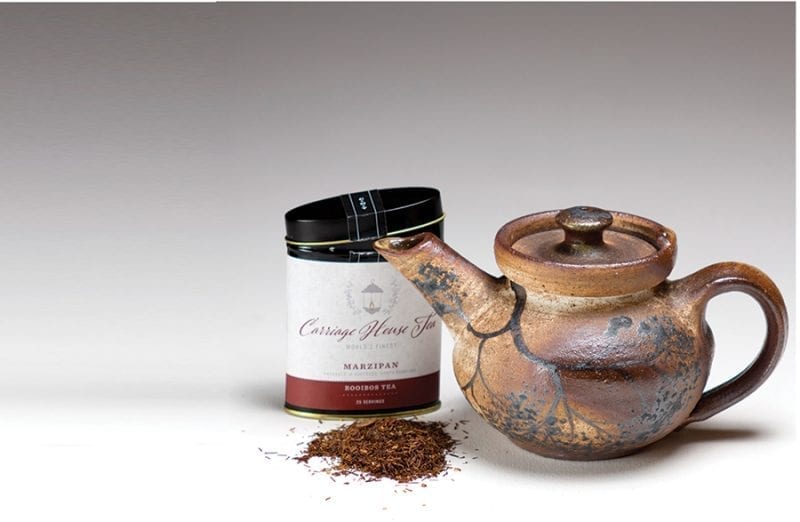
From the Ground Up
Michael Mahan’s passion is wood-fired pottery. “Wood-firing has a different look to it, and my kiln produces a lot of ash that flows through the kiln and lands on the pot,” he says. “It affects the finish and the color of the pot. It’s a more earthy look.” Mahan, a Miami native, opened From the Ground Up in 2000, making functional and decorative pottery inspired by the traditional potters of Seagrove. His studio features plates, bowls, cups, mugs, casseroles, colanders, pour-over coffee carafes and more. Some of his work is adorned by tree designs, etched, drawn or impressed into the clay. If you come for the tea, snack on baked goods made by Mahan’s wife, Mary Holmes, and sip organic coffee, roasted and brewed by Mahan.
172 Crestwood Road, Robbins
Dean & Martin Pottery
Jeff Dean and Stephanie Nicole Martin started Dean & Martin Pottery in 1999. Each brings a distinct style to the studio with their decorative and functional wares. Martin’s pop culture-themed mugs, cups and plates feature ceramic decals of musicians and activists such as Angela Davis, Elvis, Jane Fonda, Dolly Parton and Prince. “A lot of people ask about how the decals are done,” she says. “That is something we’re happy to explain to everyone when they come in — and answer any questions about studio life.” For her serving pieces, Martin uses the sgraffito technique — scraping clay after it’s hardened — or hand-painted floral designs.
Clean lines and form mark Dean’s style on his functional plates, bowls and tumblers. “It’s a mix between traditional and contemporary,” Martin explains. “The forms are more traditional, but the glazes are more contemporary.” One of Dean’s oldest and most popular dinnerware patterns is Sunset, named by his customers. It features yellow with copper reds and forest greens and is made using a Japanese technique called tenmoku, an iron-saturated glaze that brings out the blacks and browns on the bottom.
7739 Nathan Lane, Seagrove
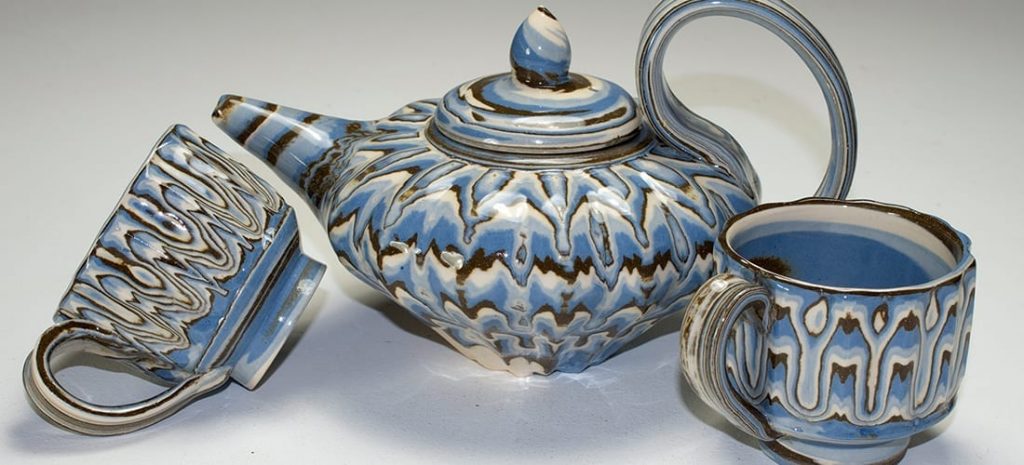
Eck McCanless Pottery
Eck McCanless is a second-generation potter. His mother bought her first pottery wheel in 1979 to make furniture for her doll houses. McCanless and his brothers played with the scraps and sometimes the wheel. As a teen, he worked with his parents, who, by that time, had turned their pottery hobby into a business. “We started out as unskilled labor and accidently apprenticed for them while trying to make a few bucks,” he says.
McCanless started making pottery professionally in 1993, developing his skills with crystalline pottery. His dad introduced him to techniques such as salt ware and raku firing, a Japanese ceramics technique. After 18 years, McCanless opened a studio in 2011. Much of his work is agateware, which is made by mixing multiple colors of clay together to create a marbling or wood-grain effect. “It’s different colors of clay spiraling all on the wheel at the same time,” he says.
At Tea with Seagrove Potters, McCanless will have teapots, tea sets and pitchers for sale, plus his usual wares. He’ll also be on the wheel doing demonstrations. “The opportunity for me to show off my work is like being an ambassador for clay and Seagrove,” he says. “It’s a good way to give a newcomer to Seagrove an introduction to these few places.”
6077 Old US Hwy 220, Seagrove
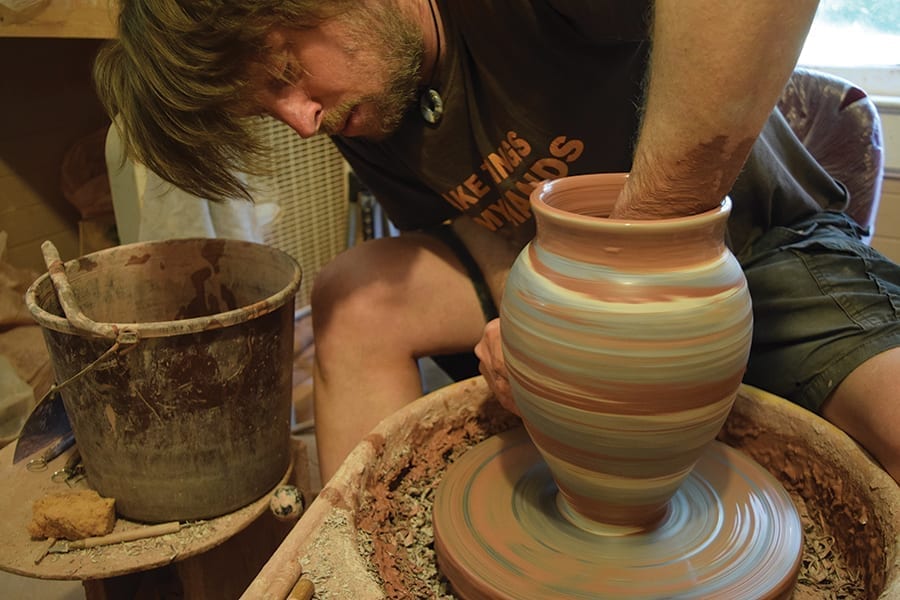
Red Hare Pottery
Bonnie Burns learned the art of pottery-making from her friend, Charlotte Wooten Fenberg, at Humble Mill Pottery, another Seagrove studio. Burns opened Red Hare Pottery in 2002 after painting pottery for Fenberg for five years. Her work, along with the work of her husband, Benjamin Burns, is showcased in Great White Oak Gallery. Burns’ dinnerware — plates, bowls, saucers, teacups and mugs — is adorned with colorful, simple illustrations of chickadees, cardinals and flowers. “I do a lot of birds; I do a lot of nature,” Burns says. “I look out my window, and I’ll see trees and put that on a piece. Nature is my muse.”
437 N. Broad St., Seagrove
Thomas Pottery
Bobbie Thomas wasn’t always a potter. Her first career was in data management, but for years, she and her husband, Scott Thomas, made pottery as a hobby. Thirteen years ago, Bobbie decided to turn her pottery-making into a business. Now, she makes trays, platters and sculptures of woodland creatures at the studio she shares with her husband. In addition to making pottery, Bobbie Thomas offers hands-on classes for groups and events. She teaches how to make plates, bowls and ornaments using simple techniques and designs. Before browsing, Bobbie recommends grabbing a treat and tea on the porch. Honey pots, teapots, sugar and creamer sets, bowls, and cups fill the sales cabin at Thomas Pottery, along with other wares.
1295 S. NC Hwy. 705, Seagrove
WANT TO GO? Shop for teacups, teapots and an assortment of functional and collector pottery at Tea with Seagrove Potters, 10 a.m. — 5 p.m. March 14. Pick up a map at any of the galleries, where you can munch homemade baked goods while sipping Mary Murkin’s Carriage House Tea from nearby Asheboro.
Another tea will be held Aug. 15, and for other pottery events including kiln openings, open houses and festivals visit the calendar page at heartofnorthcarolina.com.
While you’re in the area, visit the North Carolina Pottery Center. It’s open from 10 a.m. to 4 p.m. Tuesday through Saturday. The newest rotating exhibit, N.C. Wood-Fires: Then & Now, runs through June 20. 233 East Ave., Seagrove.
ncpotterycenter.org SP